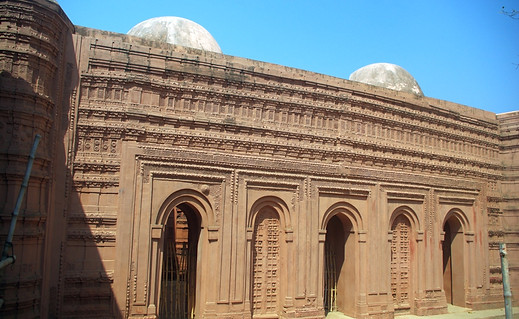
Terracotta carvings inside the Dewanji Temple, Hetampur


Historical Places

In the Rig Veda, Aitareya Brahmana, in the epics Ramayana and Mahabharata, as well as in various Puranas, five regions of Eastern India are mentioned, namely Anga, Banga, Kalinga, Sumha and Paundra. During that time, Birbhum was known as Sumhabhoomi. This Sumhabhoomi was later known as the Rarh region. The Rarh region is also mentioned in Alexander's invasion of India during the Maurya era or earlier. Many people think that the name Maurya is connected to the names, Mordighi, Morgram and Mayurakshi.
Baladitya-branded gold coins from the Gupta era have been discovered in Bara and Nanur. Many people think Chandragupta II's poet, Kalidasa, resided at Nanoor's Beluti village. Several Pala Rajas artifacts have been discovered in the Paikar settlement near Murai. It is well known that Labpur was formerly called as Samalabad after Shyamal Varma. Senrajrangsh, a town with Birnagar as its capital, was located close to Rajgram. The book Ain-e-Akbari by Abdul Fazl has mention of this region. Murshid Quli Khan partitioned Bengal into 13 chaklas in 1722. Birbhum fell under Murshidabad among them. Lord Cornwallis combined Bankura and Birbhum in 1887. Later, Birbhum was given its own district status.

Imambara, Rajnagar

Historical Landmarks: Here are some historical landmarks and locations that tourists can visit -

Motichur Masjid, Rajnagar

Rajnagar: Bir Singh was the monarch while Rajnagar served as the centre of Birbhum. The Virarajas were his offspring. Many claim that this district's name, Birbhum, was inspired by Bir Singh or Bir Raja. Later, in 1600, Joned Khan assassinated Bir Raja and assumed the throne. Asad Ullah Khan was this dynasty's most effective king (1697-1718). This Pathan clan was made to bow to the British after the Palashi conflict, but the monarch stayed in Rajnagar with dignity for many years.

What to see: Rajnagar's Motichur Mosque, Nahwatkhana, Kalidah, and Imambara. In addition, it is possible to observe the gab tree where Mongla Majhi, one of the heroes of the Santal insurrection, was hung.
How to go: The Suri Highway is close to Rajnagar. You will pass the shrine to Data Baba on the way. Nearby cities and sites include Bakreswar, Dubrajpur Mama-Bagne Pahar, and Hetampur Rajbari.

Motichur Masjid, Rajnagar

Hetampur Rajbari

Hetampur: Raghvananda, a Rajnagar royal servant, established the settlement of Raghavpur. The hamlet was afterwards taken by Rajnagar King Badiuzzamal's commander Hatem Khan, and when he did, Hetampur was named in his honour. Danbir Ramranjan Mukhopadhyay, afterwards received the title of Raja from the British on March 17, 1875.

What to see: The palace of the Ranjan kings, Ranjan Prasad, is a remarkable castle. You may still picture antique horse-drawn vehicles, palanquins, etc. at this location. You may find Shiva, Gauranga, and Saraswati temples in the village. Other Hatem Khan-era monuments include the Hafez Khan Dam, Sherina Bibi's burial, and others.
How to go: The Panagarh-Morgram Expressway connects Bolpur and Illambazar, and Siuri and Dubrajpur are both accessible from there. Keep in mind that Rajnagar, Dubrajpur, and Bakreshwar are close by, thus the other locations can also be checked.

Ranjan Rajas' Rajbari

Raipur Rajbari

Raipur: On the route from Bolpur to Illambazar, Raipur falls a short distance away. According to legend, it was formerly known as Adampur and then changed to Raipur to honour the Rai Chowdhury landowners. According to some, the King of Bardhaman gave the title 'Rai' to Bishambar Singh, and thus, the name of the land became Raipur.
It is documented that Lalchand Dey travelled from Chandrakona in Medinipur to this area in 1764 with roughly 1000 Tantubayas and acquired zamindari rights from the Rai Chaudhuris. His son Shyamkishore, who was given the name Shyambati, made a fortune by selling cloths of Chip Sahib's hut. However, Lord Satyendra Prasanna Singh, one of the sons of the family, was elected President of the Congress's Bombay Session in 1915. He was also appointed as the Governor of Bihar, Odisha in 1920. Santiniketan or Visva Bharati is built on the donation of this family.

What to see: A visit to the Singh family's crumbling royal mansion gives the impression that history is gazing in amazement at a bygone era. Surtheshwar Shiv Mandir, Shalbon of Illambazar, and the Fossil Park of Amkhai village are all in close proximity to Raipur.
How to go: From Bolpur, take a toto or a small automobile. The major draw is the dense foliage that lines both sides of the walkway.
Other Locations: Surul Rajbari, next to Bolpur, is well known for its Durga Puja celebrations. The route from Kirnahar to Katwa passes close to Sonarandhi Rajbari. Additionally, if you are interested in history, you may find different relics from the past in the villages of Paikar, Mitrapur, Bara, Birnagar, Nanoor, etc.

Surul Rajbari



